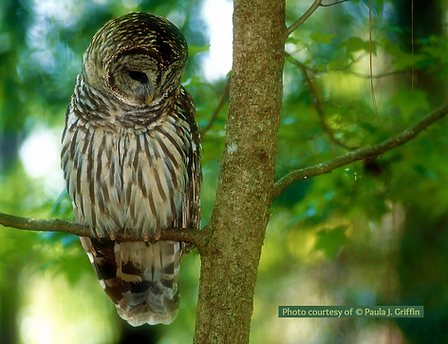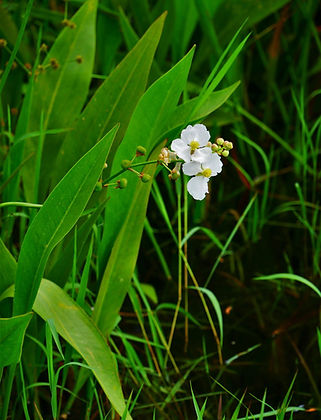Bagdad Living Com

Pond Creek

Pond Creek - Central Portion
The headwaters of Pond Creek are found in the uplands of Chumuckla in Santa Rosa County, Florida. From an elevation of 200 feet, Pond Creek flows for over 22 miles before it empties into Blackwater River.
Pond Creek drains approximately 100 square miles of the western central portion of Santa Rosa County. Originating from rain water collections in tupelo-cypress and seepage swamps, numerous branches and smaller creeks form and converge into Pond Creek.

(Above) Nyssa biflora, commonly called the Swamp tupelo or Swamp black-gum, is a species of tupelo specifically adapted to wetland habitats like this swamp where water levels can vary depending on the season.

Photo courtesy of © Paula J. Griffin
Most of the upper reach of Pond Creek is surrounded by rich soil deposits ideal for farming. A natural riparian zone buffers the margins of Pond Creek from the cultivated lands. Within the riparian, diverse vegetation provides an excellent habitat for wildlife.
(Left) Barred Owls (Strix varia) are prevalent along Pond Creek where they are known to prey upon small vertebrates such as birds, reptiles, and amphibians.
In the central portion, Pond Creek flows through approximately one-half mile of the Santa Rosa Creek Band of the Lower Muscogee tribal grounds. These tribal grounds amount to 93.43 acres of mostly wooded forest which are used as a wildlife sanctuary for the release of rescued and rehabilitated wildlife.
(Right; Below) The Eastern Screech Owl (Otus asio) is Florida's smallest owl. Pictured here are the red and brown color-morphs of this species; a gray color-morph is also found. Both of these owls were rehabilitating from injuries at the Wildlife Sanctuary of Northwest Florida and were released to the wild once healed.


Historically, the forest consisted of large stands of virgin Longleaf yellow pine. In 1828, the abundance of this timber lured Joseph Forsyth into purchasing a partially developed tract of land located on the lower portion of (Mill) Pond Creek in Santa Rosa County.
Forsyth partnered with Andrew and Ezekiel Simpson to further develop this site, known as Arcadia, into the first and largest Early American water-powered mill complex in Florida. The series of mills included a saw mill, grist mill, shingle mill, cotton textile mill, and a bucket and pail factory.
Arcadia Mill thrived in producing lumber goods until 1840 when Forsyth built a new lumber mill at the mouth of Pond Creek and Blackwater River which he named Bagdad.
(Right) Remnants of the ironstone dam are visible along Pond Creek at historic Arcadia Mill which was the first and largest Early American water-powered mill complex in Florida. Among its various operations was a quarry for ironstone, which was used to build the industrial facilities.

Historic Arcadia Mill
(Left) This Yellow Warbler (Setophaga petechia) was sighted in the canopy along the Arcadia Mill boardwalk where birding enthusiasts often find migratory species of song birds.
(Below) The trail at Arcadia provides an excellent opportunity to view wildlife while visiting various habitats along this portion of Pond Creek.


Mayo Park Kayak Launch
Pond Creek meanders a few miles passed Arcadia Mill before reaching Mayo Park Kayak Launch. The park is a favorite recreational site where visitors can spend the day or set out on a journey. As the creek gradually widens, a series of oxbow lakes offer many options for exploration.
(Left) Mayo Park Kayak Launch is a favorite recreational site on Pond Creek. From here, the creek is navigable for about 1.5 miles upstream and 2.5 miles down stream where it empties into Blackwater River.
(Below) Flowers of the Bull Tongue Arrowhead (Sagittaria lancifolia) contrast beautifully against their lush green foliage at Mayo Park Kayak Launch.

The submerged portion of the plant provides a habitat for many micro and macro invertebrates which are a food source for fish.

(Above) Several mating pairs of Barn Swallows (Hirundo rustica) have constructed elaborate mud nests on the underside of the Highway 90 bridge at Mayo Park. These agile flyers feed almost exclusively in flight on insects.
Pond Creek is part of the Blackwater River watershed. Many species that reside on Pond Creek or migrate through the area are protected by the Florida Fish and Wildlife Conservation Commission (FWC) and have well-developed programs designed for their conservation, management, or recovery.
Wildlife sightings are more likely to be species that inhabit the swamps or the creek itself. Snakes, turtles, and an occasional beaver are common to the creek while raccoons, skunks, bobcats, and armadillos frequent the water's edge.
(Right) This unhappy Raccoon (Procyon lotor) was caught in a heavy downpour at daybreak. Raccoons are a native species of Florida and are considered beneficial in controlling populations of insects and rodents.


(Above) Bald Eagles (Haliaeetus leucocephalus) are known to nest on the lower reach of Pond Creek. Their numbers have slowly increased as a result of conservation efforts and are no longer considered endangered in Florida.
Hawks, Osprey, and Vultures are plentiful as well as ducks and wading birds. Bald Eagle numbers are slowly increasing as this species recovers from endangerment. Owls are more likely to be heard than seen although a keen eye might see one perched in a tree.
While numerous resident and migratory bird species are found on Pond Creek, those that are common to both fresh and brackish waters are more prevalent towards the mouth.
Ideally, preservation of Pond Creek and its surrounding habitat would give wildlife its best chance of survival. Unfortunately, much of the land surrounding the creek is privately owned making this natural resource more difficult to protect. An ever-increasing amount of trash continues to find its way into the creek along with undesirable runoff from urban sprawl.
In the village of Bagdad, a strong sense of community exists where stewardship is key. Each spring, the Blackwater Pyrates collaborate efforts to remove trash and debris from the navigable portions of Pond Creek during their ''Blackwater River Cleanup''.

Photo courtesy of © Paula J. Griffin
(Above) Green Herons (Butorides virescens) typically hunt for prey along the water's edge or from floating vegetation. They sometimes lure fish using small items like twigs, feathers, or insects as bait.

Likewise, members of the Bagdad Waterfronts Florida Partnership work year-around in an effort to protect the natural resources in and around the village of Bagdad. This includes the protection and development of the Bagdad waterfront which encompasses Blackwater River, Pond Creek, and Oakland Basin.
(Left; Below) The Florida Gulf & Atlantic Railroad trestle spans Pond Creek about 1.4 miles past Mayo Park. In 1881, the Pensacola & Atlantic Railroad began construction on the original railway across the sparsely populated panhandle of Florida, completing it in 1883.

Florida Gulf & Atlantic Railroad Trestle
About 1.4 miles past Mayo Park is the Florida Gulf & Atlantic Railroad trestle. In 1881, the Pensacola & Atlantic Railroad company began construction on the original railway across the sparsely populated panhandle of Florida. It was completed in 1883, connecting the towns of Milton, Bagdad, and Pensacola to the Apalachicola River near Chattahoochee.
This area of Pond Creek has some of the most beautiful scenery yet. The lacy canopy of mixed hardwoods, cypress, and pine offers a superb habitat for wildlife viewing while aquatic vegetation creates an excellent habitat for freshwater fishing. Both of these draw nature enthusiasts and anglers from all over.

Pond Creek Bridge is approximately one mile past the Florida Gulf & Atlantic Railroad trestle. The original bridge and its 1918 replacement were both built of wood, connecting the village of Bagdad to the town of Milton. On Aug. 17, 1946, a ceremony was held to open the new concrete bridge which happily replaced the previous derelict structure.

(Above) The mouth of Pond Creek is subject to tides and the influx of saline water which makes it a favorite site for anglers. A combination fishing license is recommended as both fresh and salt water species of fish are caught here.

(Above) Pond Creek Bridge spans Pond Creek at its mouth where it empties into the Blackwater River. The original bridge and its 1918 replacement were both built of wood whereas this bridge was built of concrete in 1946.
At the confluence of Pond Creek and Blackwater River is Bagdad Mill Site Park. This historic site is where Forsyth and Simpson relocated their lumber mill and built the town of Bagdad. Bagdad Mill Site Kayak Launch is at the south end of the park, just a short distance from the mouth.
(Upper Right) Calm conditions at daybreak allow for a picturesque scene before the breeze picks up. This view is from the Pond Creek Bridge where Pond Creek empties into Blackwater River.

Mouth of Pond Creek
Click on the BMHT logo above to link to the Blackwater Maritime Heritage Trail website

(Above) Bagdad Mill Site Kayak Launch is one of four trail-heads for the Blackwater Maritime Heritage Trail along the lower reach of Blackwater River. Use the BMHT website to plan a trip from Mayo Park Kayak Launch to here.
As always, use care on the waterways. Be aware of weather, creek, and river conditions before you launch. Adhere to FWC Regulations and Boating Safety Requirements. Understand that much of Pond Creek is remote wilderness where you are in control of your own personal safety.

Click on the FWC logo above
for Boating Safety link
Have a float plan and let someone know where you are going and when you are due back. By following these suggestions, one can expect to have a memorable experience exploring the beauty and historic relevance of Pond Creek.
(Left) This couple is practicing safe boating by wearing their life jackets.

On behalf of BWFP and FPAN, we hope you visit the Historic Village of Bagdad. From our shores, you are welcome to launch into your own adventure on the beautiful Blackwater River and use the Blackwater Maritime Heritage Trail to enrich your experience.

Return








